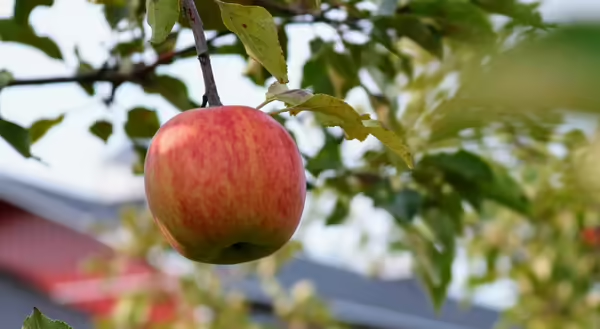
Note: this is the fifth post in a series on fruit trees. Read part one.
Young fruit trees in the home orchard should begin to fruit once the tree has become established. Several conditions will need to be met before that happens. Some of them we cannot control and others, we can help along. The four big factors are: typical age for the tree to bear, tree health, weather, and proper pollination.
Age
Fruit trees that are moderate growers will often begin to bloom ahead of faster or slower growing trees. Apples can start to flower in as little as two years – although three is more common – and sour cherries also are in the two- to three-year range, while plums take three to five years. Fruit trees ordered from a fruit tree supplier may only be one year old and sold as a whip. Those fruit trees purchased from a garden center or retail nursery are usually at least two years old, branched, and may have blooms or even the occasional fruit. That said, do not expect to see flowers and fruit again for a couple more years as the tree will be establishing a root system.
Health
Tree health also will influence how soon blooms start to show up. We want a healthy tree, but not one that is overly vigorous, which will delay the formation of fruit buds. If you allow leaf diseases to establish before fruiting, that can reduce your potential yield by about 20 percent. Letting insects feed at will makes that percentage drop even further. Some insects can hurt the tree, as well as the fruit. A regular spray program, either organic or inorganic, starting while the trees are young will get you off to a good start.
Weather
While we cannot control the weather and climate, there is something we can do to cushion the impact. Plant your fruit trees in the best locations in the landscape. Hardy fruit trees actually need a dormant period, and later a chilling period, to flower each year. Avoiding low-lying spots in the yard help protect the more sensitive flower buds from those late frosts. Soil that drains well avoids root rots too. The most sensitive fruit trees are apricots and sweet cherries. Next in the list are peaches and nectarines. Plums, pears, and sour cherries are second to the top and apples are hardiest. The best trees to start with around here are apples. Once you master those, venture into the less hardy fruit trees. Peaches for example may only provide a crop every few years due to fruit buds being killed by our severe winter temperatures.
Pollination
The last condition that must be met and one we do have control over is that of proper pollination. Apples, for example, will require cross pollination. You will need two trees of different varieties blooming at the same time. If you chose a variety that is listed in the fruit catalogs as being male sterile then you will need yet another variety to ensure all three trees can produce apples. Not all apples are self-unfruitful, but always do better if cross pollinated. Other self-unfruitful trees include pear, American plums and sweet cherries. In the urban areas, a flowering ornamental crabapple can serve as a pollinator for apples as they are very closely related, provided they are blooming at same time as your fruit trees. Since fruit trees are pollinated by flying insects, that could be the crabapple several doors down.
Home Orchard / Fruit Tree Blog Series:
- Fruit trees have a place, even in a small yard (January 25, 2021)
- Fruit tree pollination is complicated (February 1, 2021)
- Benefits of training your apple and fruit trees (February 9, 2021)
- Manage pests and disease in home orchards (February 15, 2021)
About the author: Richard Hentschel’s expertise extends across several subject areas with specialties in lawn care, fruit tree production, woody ornamentals, and home and community gardening. During his 45-year career in horticulture and agriculture, Hentschel became a well-known and respected expert for commercial and homeowner audiences, industry organizations, and media. He retired from University of Illinois Extension in April 2022 with nearly 30 years of service as a Horticulture Specialist and Educator in northern Illinois.
